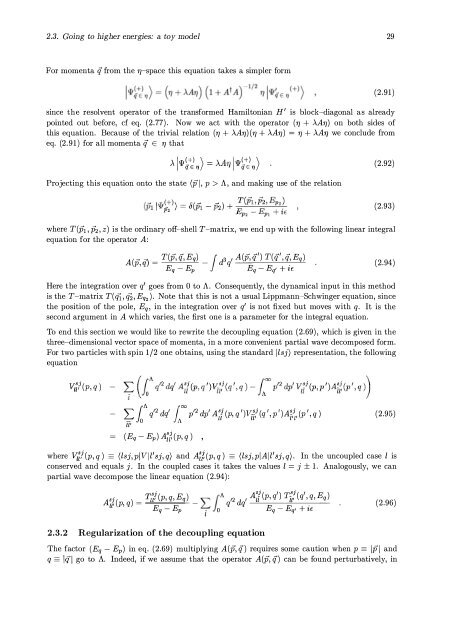The Nucleon-Nucleon Interaction in a Chiral Effective Field Theory
The Nucleon-Nucleon Interaction in a Chiral Effective Field Theory
The Nucleon-Nucleon Interaction in a Chiral Effective Field Theory
You also want an ePaper? Increase the reach of your titles
YUMPU automatically turns print PDFs into web optimized ePapers that Google loves.
2.3. Go<strong>in</strong>g to higher energies: a toy model 29<br />
For momenta ij from the 1]-space this equation takes a simpler form<br />
(2.91)<br />
s<strong>in</strong>ce the resolvent operator of the transformed Hamiltonian H' is block-diagonal as already<br />
po<strong>in</strong>ted out before, cf eq. (2.77). Now we act with the operator (1] + )'A1]) on both sides of<br />
this equation. Because of the trivial relation (1] + )'A1]) (1] + )'A1]) = 1] + )'A1] we conclude from<br />
eq. (2.91) for all momenta ij E 1] that<br />
), Iw�+) ) =<br />
q E 1] " q E Ti<br />
)'A'l1 Iw�+) )<br />
Project<strong>in</strong>g this equation onto the state (pi, p > A, and mak<strong>in</strong>g use of the relation<br />
(2.92)<br />
(2.93)<br />
where T(Pl ,P 2 , z) is the ord<strong>in</strong>ary off-shell T-matrix, we end up with the follow<strong>in</strong>g l<strong>in</strong>ear <strong>in</strong>tegral<br />
equation for the operator A:<br />
A(� ;1\ _ T(p, ij, Eq) _ ! d3 , A(p, ij') T(ij',ij,Eq)<br />
.<br />
p, q ) - E E q E E<br />
q - p q - q' + Zf<br />
(2.94)<br />
Here the <strong>in</strong>tegration over q ' goes from 0 to A. Consequently, the dynamical <strong>in</strong>put <strong>in</strong> this method<br />
is the T-matrix T(ql,q""2,Eq2 ). Note that this is not a usual Lippmann-Schw<strong>in</strong>ger equation, s<strong>in</strong>ce<br />
the position of the pole, Eq, <strong>in</strong> the <strong>in</strong>tegration over q' is not fixed but moves with q. It is the<br />
second argument <strong>in</strong> A which varies, the first one is a parameter for the <strong>in</strong>tegral equation.<br />
To end this section we would like to rewrite the decoupl<strong>in</strong>g equation (2.69), which is given <strong>in</strong> the<br />
three-dimensional vector space of momenta, <strong>in</strong> a more convenient partial wave decomposed form.<br />
For two particles with sp<strong>in</strong> 1/2 one obta<strong>in</strong>s, us<strong>in</strong>g the standard Ilsj) representation, the follow<strong>in</strong>g<br />
equation<br />
Vi:! (p, q)<br />
� 0<br />
InA [00 . . .<br />
'2 ' '2 ' SJ , sJ " sJ ,<br />
q dq P dp All (p, q )Vil' (q ,p )Al'l'(p ,q)<br />
A<br />
11'<br />
(Eq - Ep) A:f, (p, q )<br />
(2.95)<br />
where Vi:!(p,q ) == (lsj,plVll'sj,q) and A:f,(p,q) == (lsj,pIAll'sj,q). In the uncoupled case 1 is<br />
conserved and equals j. In the coupled cases it takes the values 1 = j ± 1. Analogously, we can<br />
partial wave decompose the l<strong>in</strong>ear equation (2.94):<br />
sj ( ) A AS2( ') T!j( , E)<br />
ASj ( ) - Tl!' p,q, Eq _ " In '2 d ' 11 p,q 11' q , q, q<br />
q p _<br />
11' p, q -<br />
E - E � q q E - E +'<br />
I<br />
0 q q' Zf<br />
2.3.2 Regularization of the decoupl<strong>in</strong>g equation<br />
(2.96)<br />
<strong>The</strong> factor (Eq - Ep) <strong>in</strong> eq. (2.69) multiply<strong>in</strong>g A(p, ij) requires some caution when p == IPI and<br />
q == l












